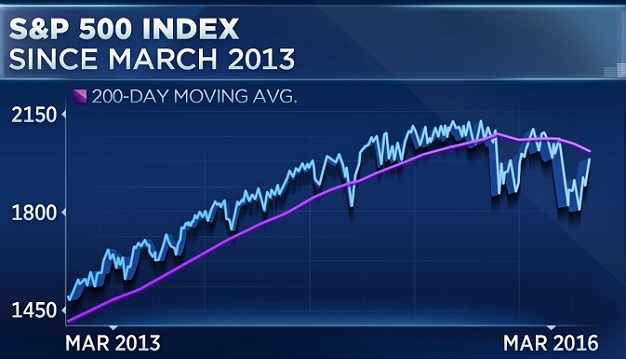The most common definition of a bear market in stocks? A major index needs to fall 20% from a high-water mark. And while that is precisely what has happened for most gauges of stock health – MSCI All-Country World Index, Nikkei 225, Stoxx Europe 600, Shanghai Composite, U.S. Russell 2000, U.S. Value Line Composite – the Dow and the S&P 500 remain defiant.
Yet there’s another way to view bulls and bears. In particular, chart-watchers often use the slope of a benchmark’s long-term moving average. It is a bull market when the 200-day moving average is rising. During these times, investors often benefit when they buy the dips. In contrast, when the 200-day is sloping downwards, it may be a “Grizzly.” During these days, investors successfully preserve capital when they raise cash by selling into rallies.
There’s more. During stock bears, stocks frequently hit “lower highs” and “lower lows.” That’s exactly what investors have experienced since May of 2015.

There is little doubt that – at the moment – we are witnessing the “rolling over” of the 200-day moving average. The exceptionally popular measure of market direction is sloping downward, giving support to the notion that a bearish downtrend is in command.
Technical analysis notwithstanding, there are other reasons to believe that the stock bear will maul and mangle. Fundamental analysts note that the Q1 2016 S&P 500 earnings are set to record a decline of -8.0%. That is going to register a fourth consecutive quarter for year-over-year declines in corporate earnings per share – the first such sequence since 2008 (Q1, Q2, Q3, Q4).
“But Gary,” you protest. “It’s only the energy companies. You should just exclude them from consideration.” (Like technology in 2000? Financials in 2008?)
Actually, it is not just the energy sector. Seven of the 10 key economic sectors will serve up profits-per-share disappointments. Telecom, health care and consumer discretionary companies may be the only sectors to provide a positive boost in the upcoming earnings season. Still, get a gander at the earnings expectations at the start of the year versus the earnings expectations at the beginning of March. It only took two months for analysts to lower their expectations for every single stock segment – percentage revisions that have not dropped this fast since the Great Recession.









Leave A Comment